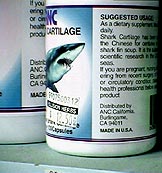
|
|
|
|
|
|
Shark Info (12-15-1999) |
Author |
|
Intro: |
Shark Info |
|
Main article: |
Dr. E. K. Ritter |
|
Article 1: |
Shark Info |
|
Article 2: |
Harald Gay |
|
Fact Sheet: |
Dr. E. K. Ritter |
|
The shark fin market in San FranciscoBy Harald Gay "Und der Haifisch, der hat Zähne...", Bertold BrechtBut what happened to his fins? For some time now, the reality of everyday fishing life has no longer had anything to do with prose or the good old days of Christian sea voyages with their related fishing activities. This fact was made painfully clear to me and my friends as we recently walked through Chinatown in San Francisco. «The sea is wide, the sea is blue, something is swimming in the sea ...», Heinz Erhardt... If we continue on this basis, sharks will soon disappear from the oceans! As already published in earlier issues of Shark Info and other publications, sharks, and especially their fins, have become the target of a special fishing branch. The trade with shark fins is flourishing since the demand from major importing countries, such as China and Taiwan, is great and still shows a tendency to increase.
For the fishing industry which is plagued by dwindling catch results and their crews, who are poorly paid, shark catches represent a welcome enhancement to their poor income (about 30 dollars per pound). Entire sharks, often caught as a byproduct with other catches, are usually of no particular worth to fishermen since shark meat is not considered a valuable gourmet product and does not yield high prices at auctions. Only the fins which - depending on the species - represent a mere 8 to 14% of a shark's body weight, yield good money on the markets! The fins are simply cut off the shark and dried under the open sky. Particularly atrocious is the common practice of not even killing the sharks before cutting off all their valuable fins (pectoral, dorsal and sometimes even tail fins). The mutilated, still living animals are then thrown back into the ocean to suffer an extremely painful death. "He who cannot smile should close his shop", Lao-tseThis smile disappeared really fast as the Chinese sellers became aware that we were trying to document the extent of the trade in shark fins and shark cartilage through photos and film. More than once we were forced to leave a store hastily to avoid bodily threats. "No, no, for your taste you need only the best quality", I heard an adept dealer argue. He was talking to an elderly women holding a dried shark fin in her hands. The woman's companion looked at the fin with some degree of awe and was impressed. The fact that prices for shark fins have exploded and that the fin in the woman's hands cost around 250 dollars did not seem to deter the modestly dressed woman and her companion. Prompted by other sales people to leave the store, we were unable to determine if the dealer's efforts were finally crowned with success. "Superstition only uses the wrong means to satisfy real needs", Johann Wolfgang von GoetheIn the Far East shark fins are sold as an aphrodisiac, a term applied to drugs or foods - for example, certain seasonings, alcohol or hormones - which are said to enhance sexual drive and male potency. The effectiveness of many symbolic and mystical substances seems to be based more on the belief in love potions and traditions rather than on certified fact. Just like tiger bones and testicles, shark fin soup is traditionally defined as being an effective substance to enhance male potency, especially in the far eastern culture. It surely cannot have anything to do with taste since shark fins are bland and are usually cooked for hours in a chicken broth with herbs and spices to make them palatable. We can only surmise how many sharks have to die for the dubious pleasure of such a shark fin soup. In the People's Republic of China, shark fin soup was actually shunned, being considered capitalistic and decadent and therefore not in line with party politics. However, changes in the political system, the economic boom in special economic zones and western influences, etc., revived the taste for decadent things which rapidly regained acceptance.
Although the large number of shark fins available in many stores far exceeded our expectations, they were by far not the only items up for sale. Many types of different shark cartilage products were also available in all stores and shark meat was sold at open fish markets. Fish merchants offered apportioned leopard shark meat (Triakis semifasciata), the same species daily admired by hundreds of children and adults in the nearby Steinhardt Aquarium. Summarizing, we made the following observations in all of the stores visited: Shark fins were never offered at a price below 100 dollars per pound. The average price was around 180 to 200 dollars. The highest prices we found were around 335 dollars per pound, and 250 dollars for a single fin. In addition, a whole palette of cartilage products was available in all stores in the form of pills, lozenges and fluid concoctions. Most packages contained 50 to 100 pills and were priced at about 12 to 18 dollars. What really surprised us is the fact that these products were not manufactured, as expected, in Asia or South America, but right outside of San Francisco. "Bikinis are like statistics, they tempt while concealing that which is relevant", Aaron LevensteinWhy should it be different in the fishing industry? In official statistics, sharks are only listed as a coincidental catch, often without species identification, which is why most countries today still lack legal quotas to protect shark populations. Only a few countries have programs to register species and populations in order to obtain more accurate information on sharks in their waters. Many species migrate through thousand of miles of seawater, which makes it easy to understand why information about shark populations can only be made available on a long-term basis. On the other hand, the probability that suitable measures may be implemented too late is alarming. "Although indignation is not action, it may spur impetus to act", ScharpingUpon concluding our tour we were really shocked by what we learned and saw, and realized how much more needs to be done to guarantee the survival of the shark species into the next millennium. The ocean has turned into a self-service store for mankind, in which - at least in the past - the shelves were automatically refilled. However, for some decades now, humans have been taking more and more from the shelves without any concern for how the shelves were refilled. By now it should be clear to our civilization that limited resources should not be exhausted for reasons of superstition, for products of dubious effectiveness and simply due to rampant greed. Only a meaningful and moderate exploitation of the ocean will guarantee the long- term survival of both humans and sharks. * Harald Gay has been studying sharks for many years and is an enthusiastic diver. He is a member of the German Elasmobranch Society and active in shark protection. May be published only by indicating the source: Shark Info / Harald Gay |
|
|
|
|
|
|||||

